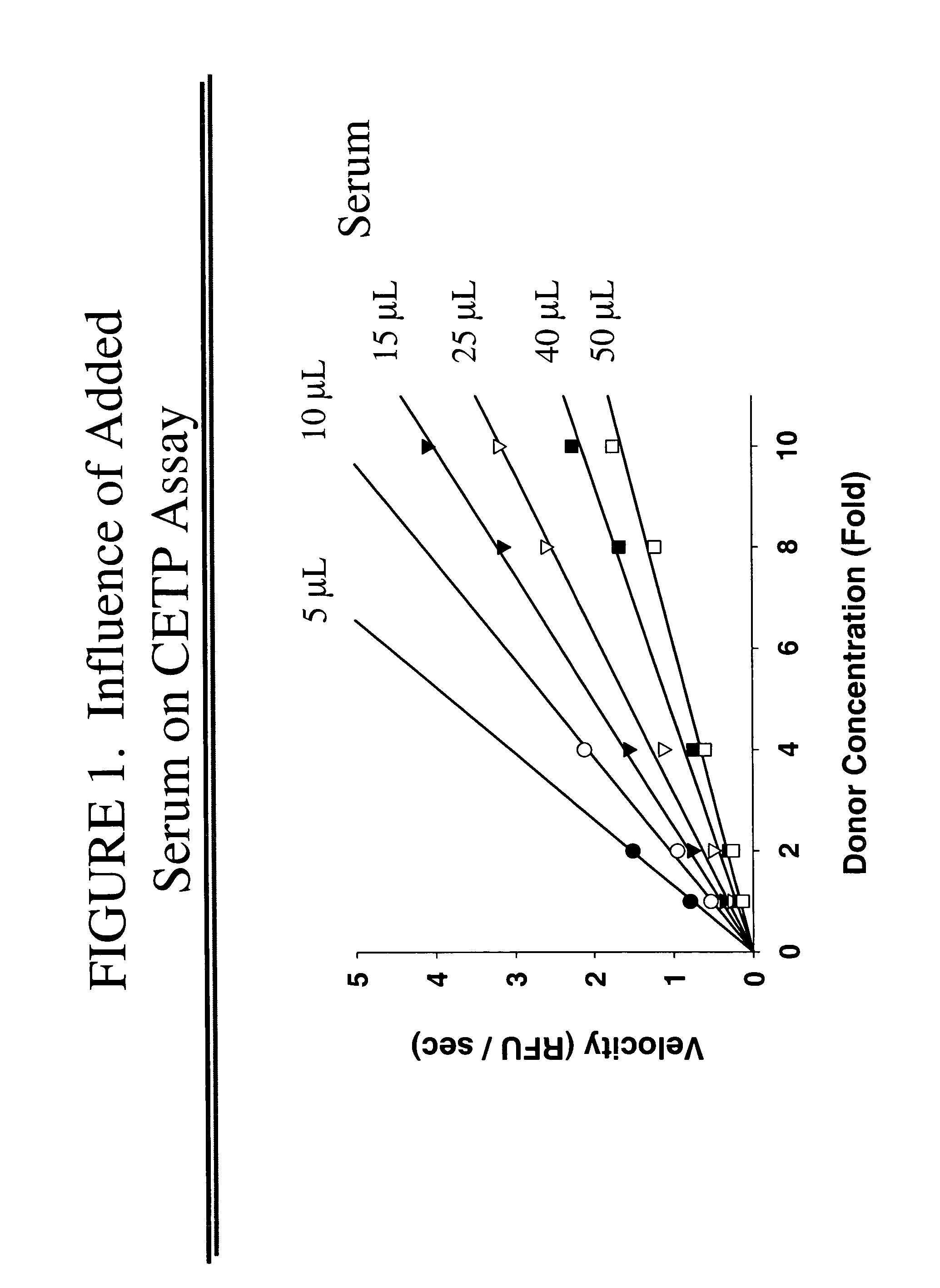Fluorescence assay for measuring the rate of cholesterol ester transfer
a technology of fluorescence assay and cholesterol ester, which is applied in the field of fluorescence assay, can solve the problems of difficult to measure small changes in the transfer rate, the inability of the assay currently used for measuring the activity of cetp to provide unequivocal validation, and the inability to adapt to high throughput screening
- Summary
- Abstract
- Description
- Claims
- Application Information
AI Technical Summary
Benefits of technology
Problems solved by technology
Method used
Image
Examples
example 1
Assay of CETP-catalyzed CE Transfer in Buffer
CETP Enzyme Source
Recombinant human CETP expressed in CHO cells was supplied by Cardiovascular Targets, Inc.
This CETP is substantially free of serum and plasma. Enzyme is stored frozen at −70° C.
Assay Conditions and Protocol
Assay Temperature: 25° C.
Final Concentrations in a 150 μL Volume:
5 ng / μl Donor Particles
17 ng / μl Acceptor Particles
1×assay buffer
0.8 nM CETP
2% DMSO or other solvent—if compounds are being tested
Protocol:
[0049]Dynex Microfluor 2 U-bottom black 96-well plates (Cat# 7205) are used.
[0050]An assay cocktail containing CETP and 1×buffer (100 μl) is transferred to a plate with a multichannel pipettor.
[0051]A compound being tested in solvent or a solvent control (3 μl volume) is added to the plate with a multichannel pipettor. Solvent for the test compound is generally DMSO. Test compounds may be preincubated in solvent (e.g. DMSO) for up to 15 minutes at 25° C.
[0052]The plate is mixed for 30 sec @ 850 rpm on Eppendorf Thermomi...
example 2
Assay of CETP in Buffered Plasma
CETP Enzyme
In this example, recombinant human CETP was obtained from CETP-expressing CHO cells rather than being purchased. Final CETP enzyme concentration is approximately 0.8 nM in plasma. Enzyme is stored frozen at −70° C.
Assay Conditions and Protocol
Assay temperature: 25° C.
Final Concentrations in a 150 μl Volume:
54 ng / μl Donor Particles
30.2 ng / μl Acceptor Particles
1×CETP buffer
CETP to 0.8 nM final
2% DMSO (or other solvent)—if compounds are being tested
Protocol:
[0055]Use a Dynex Microfluor 2 U-bottom black 96-well plates (Cat# 7205).
[0056]Prepare an assay cocktail containing 3 μL of CETP, 50 μL of plasma or serum and 47 μL of 1×buffer, and add 100 μl to plate with multichannel pipettor. In this example, volumes of added buffer are adjusted from prep to prep to keep the concentrations of CETP the same.
[0057]Add compounds being tested in DMSO (or DMSO only) in a volume of 3 μl with multichannel pipettor.
[0058]Mix plate for 30 sec @ 850 rpm on Eppend...
example 3
Assay of Native CETP in Buffered Plasma
CETP Enzyme
[0062]CETP is present in the plasma or serum fraction. Plasma or sera may be from human, rabbit or transgenic mouse donors. Use of the plasma or serum fraction allows the assay of CETP activity ex vivo in animals treated with a CETP inhibitor. Measurements using CETP in plasma or serum are possible in this assay, whereas the same measurements cannot be made in assays without a quencher because of the high background fluorescence.
Assay Conditions and Protocol:
Assay temperature: 25° C.
Final Concentrations in a 150 μL Volume:
5 ng / μl Donor Particles
17 ng / μl Acceptor Particles
1×CETP buffer
Protocol:
[0063]Use a Dynex Microfluor 2 U-bottom black 96-well plates (Cat# 7205).
[0064]Prepare an assay cocktail containing only 1×buffer and add 90-95 μl to the plate with a multichannel pipettor.
[0065]Add 5-10 μL of each plasma or serum sample to be tested for CETP activity to an assay well. (Rabbits may require 15 μL of plasma or serum). Perform trip...
PUM
| Property | Measurement | Unit |
|---|---|---|
| density | aaaaa | aaaaa |
| pH | aaaaa | aaaaa |
| pH | aaaaa | aaaaa |
Abstract
Description
Claims
Application Information
 Login to View More
Login to View More - R&D
- Intellectual Property
- Life Sciences
- Materials
- Tech Scout
- Unparalleled Data Quality
- Higher Quality Content
- 60% Fewer Hallucinations
Browse by: Latest US Patents, China's latest patents, Technical Efficacy Thesaurus, Application Domain, Technology Topic, Popular Technical Reports.
© 2025 PatSnap. All rights reserved.Legal|Privacy policy|Modern Slavery Act Transparency Statement|Sitemap|About US| Contact US: help@patsnap.com

